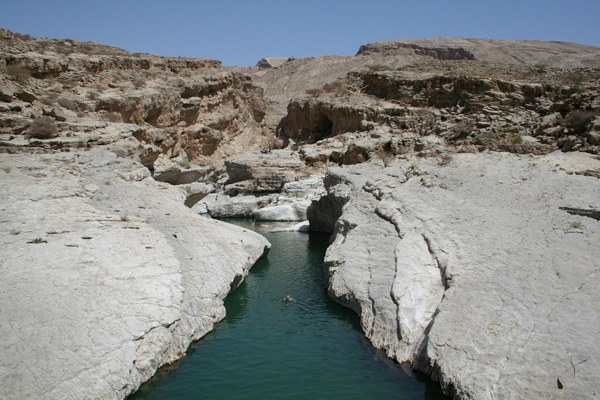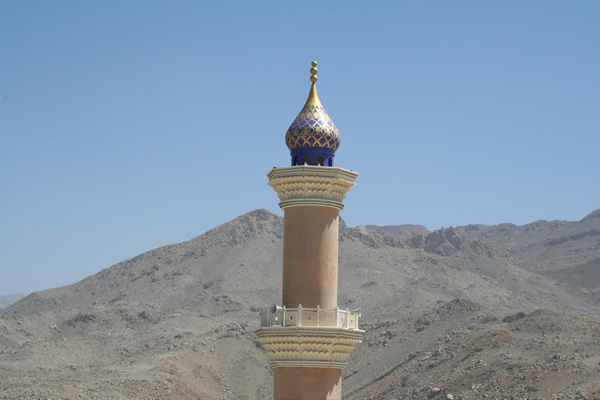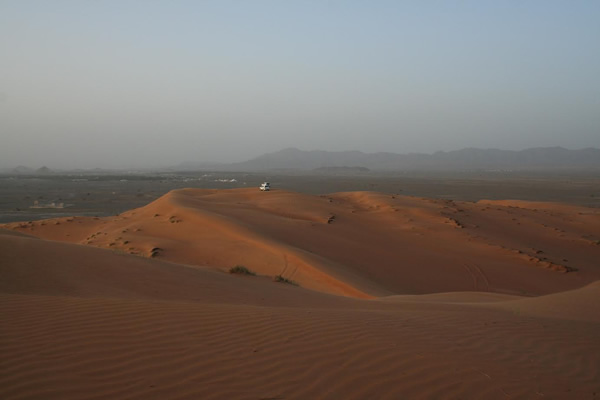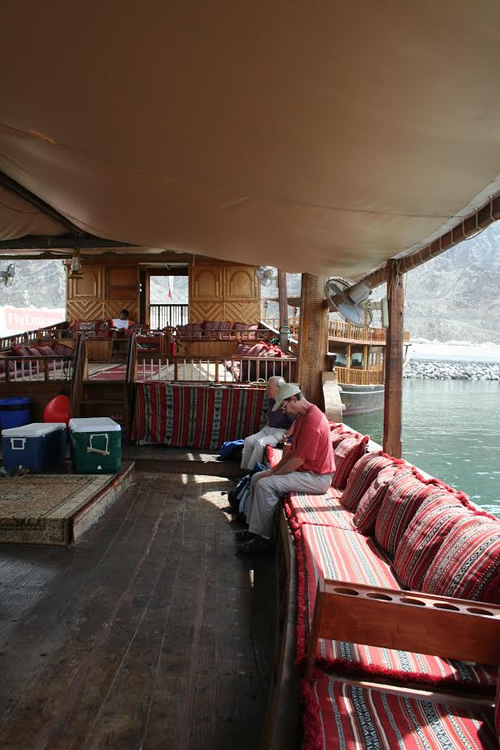Travel in Oman
A Wadi of One's Own
Article and photos by Anna
Maria Espsäter

|
|
Oman water pools at Wadi Bani
Khalid.
|
"Don't wash your compliance," the sign by the water pools at Wadi Bani Khalid boldly proclaimed, leaving the group of us sweaty hikers somewhat puzzled. I was ready to throw myself in to cool down as swiftly as possible, "compliance" and all, whatever it might be referring to. I was spending time in the Sultanate
of Oman, doing some wadi-hiking and it was hot.
Rumor has it that when the U.N. discussed Oman's independence in 1971, the delegates had to take an extended break to verify the country's location. This little-known Sultanate at the end of the Arabian Peninsula has remained largely unexplored by visitors until recent years. Nevertheless, except in the capital, Muscat, and some coastal areas, visitors are still relatively few and far between. The Omani people are keen to welcome those brave enough to venture further afield to sample the best of the nation. And there is a lot to sample. Oman is the second largest country in the region, after neighboring Saudi Arabia. The land features a coastline stretching 1,200 miles along the Arabian Sea, plenty of "Lawrence of Arabia" desert sand dunes, impressive mountain ranges, and a rich historical and cultural heritage.
Oman is a country where many men and women still don traditional garb. Men wear white dishdasha. Women wear black — but ever so colorfully embroidered — abaya. Coffee is the drink of choice, spiced up with large amounts of cardamom and poured from on high, out of large and ornate coffee pots. Traditions seem palpably alive, and oil has brought none of the glaring riches of nearby Dubai and Abu Dhabi. Instead, Oman feels quietly understated and refreshingly friendly. Having crossed the border from the Emirates by car — with a wait of six hours due to a national holiday a few days earlier — I was just getting used to hiking in temperatures hitting 38°C/99°F, and places such as Wadi Bani Khalid were a blessing. Most wadis are dry riverbeds year-round or hold water only briefly when rare rains set in. Still, a handful are filled with refreshing streams from the mountains any time of year. Wadi Bani Khalid is a beautiful oasis of green and turquoise pools surrounded by date palms. At the same time, a basic shelter serves as a changing room. Unfortunately, this wadi is open to the elements on most sides, making it very hard to be culturally sensitive. Rather than washing "my compliance," I almost flashed everyone while wearing my swimming costume. Most Omani ladies modestly get into the water fully clothed. In retrospect, following their lead would have been more culturally sensitive. Still suitably refreshed after a surprisingly cool dip, I could face the heat again.
To avoid the midday heat altogether, early morning starts are by far the best, not just for hiking but for everything from visiting the souk to socializing in the town squares. Women, as well as men, are often out full force in the cooler hours.
The following morning, we left our base in the Jebel Akhdar, or Green Mountain, part of the Hajjar range. Our group clambered into 4x4s, heading for "Diana Point." As it turns out, Princess Diana once camped here, and it is not hard to see why she did so. At 6,000 feet, the views opening up on all sides were truly spectacular, even if what is known as the "green mountain" was actually every shade of beige this time of year. The name started making more sense when turning the corner, as we found ourselves suddenly surrounded by a flourish of color and every shade of green; a terraced falaj, or irrigation system, was making the small villages positively blossom. Everything from pomegranates and peaches to sweet-smelling pink rose bushes lined our trail. We started the hike a short distance from Diana Point along the well-worn path to a village aptly named Al Ayn — meaning spring or garden.
Villages in the mountains are often off-the-beaten-track, and although not prosperous, they are well-kept and tidy. English is not widely spoken, so knowing a smattering of friendly phrases in Arabic will be helpful. A quiet walk also offers more profound insights into Omani village life, where people go about their daily business, tilling the terraces, washing in the stream, or just enjoying a coffee and chatting. An hour-and-a-half walk along the slopes and irrigation canals, alternating steeply with uphill climbs and knee-bending downhill patches, we reached the end of the day's hike at Ash-Shirayjah. Even the village sheik, the only person to speak English, stopped and enquired how we liked Oman.
Our next stop for a few nights was the town of Nizwa, one of the oldest cities in Oman, dating back to the 6th and 7th centuries. Nizwa is a former center for Islamic learning with an array of impressive historical buildings such as Nizwa Fort, a purple-domed great mosque completed in the 1650s, and one of the country's liveliest souks. Nizwa is an excellent base for exploring the city and the surrounding wadis — Wadi Tanuf and Wadi Misfah. The old village ruin of Tanuf, right next to its wadi namesake, is a pleasant — if slightly ghostly — place to picnic before setting off along the dry riverbed. I would have been tempted to give up had the scenery been less spectacular. Still, there is nothing quite like a gorge of gorgeous proportions to take your mind off the sweating and panting. An experience akin to the approach to Petra, Jordan, and the Grand Canyon all rolled into one kept me spellbound for the next hour and a half's meltingly hot hike; towering rock formations surrounded me on both sides, with happy goats skipping past. In Omani society, men and women remain separate from one another. Under the shade of two trees, an extended family sat picnicking — women and girls under one tree, men and boys under another. A kindly older man wandered over to greet me with a tray full of goat kebabs, which I thoroughly enjoyed. No wonder those goats skipping past us earlier had seemed so happy — they had managed a fortunate escape.

|
|
Minaret of the mosque at Nizwa.
|
Food in Oman is basic, straightforward, and unfussy — chicken and goat or lamb inland, fish along the coast — but there is no shortage of choices. Alcohol, on the other hand, is something that can be hard to come by. Although one of the more laid-back Muslim nations in the area, a world away from neighboring Saudi Arabia, for example, Omani society is still very traditional, and drinking is frowned upon. My guide, Assad, told me that society is changing fast, particularly in the cities. Marriages are no longer always arranged, but "sometimes if a man can't find a wife, he will ask his parents to find him one, or if he sees a girl he likes he can ask his parents to speak to her parents." Although divorce is now allowed, it is not very common. Traveling as a woman, I experienced no hassles whatsoever, and if anything, I found Omani men to be always friendly and attentive in a non-threatening way — in cities and tiny villages.

|
|
Wahiba Sands at sunset.
|
The land is often rugged and mountainous, particularly in the north, but further south lays the desert area known as the Wahiba Sands, covering 100 miles by 50 miles, with sand dunes reaching as high as 500 feet. This is the place to spend a few nights, sleeping in a desert camp under the stars, and try out some exhilarating "dune bashing" — driving (or, in my case, getting driven) in 4x4s across the sands, sometimes gliding gracefully from dune to dune, sometimes literally flying down them, the desert winds covering the tracks as you drive. Find a quiet spot and watch the dunes change from deep golds and oranges to mauves and pinks when the sun sets. With its long coastline, Oman has a history as a great maritime nation, trading with India and Zanzibar. In the northeastern corner, the shipyard at Sur still builds the famous dhows that used to ply the old trade routes. After the desert adventure, I decided it was time to do a bit of seafaring myself. However, I had to wait until I got to Muscat, the Omani capital, where you can rent one with a crew. Dhows are big, sturdy, wooden boats. I soon felt myself slipping back in time, rocked by the gentle motion of the waves, impressive mountains, and clear, translucent waters all around me, giving the place a complete air of timelessness. Perhaps it would be unfair to wish for Oman to remain a quiet backwater, but it is almost impossible not to want time to stand still here just a bit longer.

|
|
Onboard the dhow.
|
|
For More Info
Capital: Muscat
Language: Arabic and English are widely spoken except in smaller villages.
Getting There and Local
Travel: Many airlines, including national carrier Oman Air, serve Seeb International Airport, some 40 km outside Muscat. British Airways has flights via Bahrain or Abu Dhabi. Other international carriers include Lufthansa, Emirates, and Gulf Air.
Oman has a good network of roads, particularly near and around Muscat and Nizwa. Renting a car is a good option, with or without a driver, as public transport cannot reach many good hiking spots. Cars can be rented for as little as $175/week.
Tour: Another option is to join a tour, such as one offered by Intrepid in Oman.
When to go: If you focus on hiking, the season runs from early October to the end of March — any later, and it gets too hot. Summers are hot and humid. Remember that Oman is mountainous and has a desert climate, so nights can get a bit chilly.
Health: Recommended vaccinations include Hepatitis A, Typhoid, and Tetanus. Tap water is safe to drink.
Accommodation: Although Oman has an increasing number of 4- and 5-star properties and basic accommodations, mid-range hotels and guest houses are much thinner on the ground. Expect to pay up to 40-60 Omani Rials for a reasonable standard room, but if you're not scared to rough it, you can find a hostel for as little as 5-10 OMR.
Eating and drinking: If accommodations seem pricey, meals are a much better value, and good food can be had for as little as a few Rials.
Fish dishes are popular along the coast, and chicken, lamb, and goat feature heavily inland. Most dishes are served with rice, and several different spices are used in cooking, as Oman used to be part of the spice trade with Zanzibar and retains strong links with that island.
Coffee is as ubiquitous as mint tea in Morocco, and turning down a cup offer is rude. Known as Khawa, it is flavored with cardamom, which is very tasty and often very strong.
Oman is a Muslim country, and alcohol is not widely available. However, it can be bought in hotel bars and international restaurants.
Money: The
Omani Rial is divided into 100 baisas. As
of 2024, 1 OMR = 2.60 USD. Most major towns have
ATMs and exchange bureaux.
Visas: Visitor visas valid for a 1-month stay may be obtained on arrival for citizens of over 60 countries, including the European Union, USA, Canada, Australia, New Zealand, Singapore, and Japan.
Equipment: Long-sleeved shirts and pants, high-factor sunscreen, sunglasses, insect repellent, and plenty of water. Comfortable footwear is critical. Women should wear a head scarf when entering a mosque.
Guidebooks and further
reading: For a general guide to Oman,
check out the Oman
UAE & Arabian Peninsula (Multi Country Guide).
|
Anna Maria Espsäter, a native of Sweden, has lived and worked in Holland and Mexico and is currently based in London, where she works as a freelance writer. She is passionate about independent travel, particularly around Latin America and Asia. Having survived an earthquake, tropical disease, armed robbery, and assault while on the road, she still hasn't given up traveling and has the scars to prove it.
|
